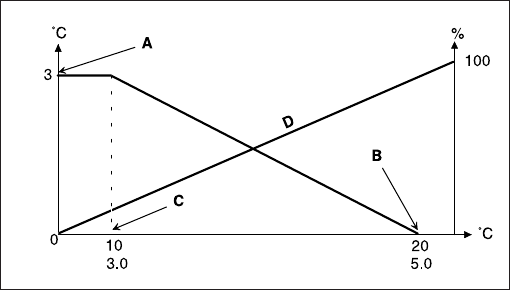
33
5.6.2 - Reset
Reset means that the active setpoint is modified so that less
machine capacity is required (in cooling mode, the setpoint is
increased, in heating mode it is decreased). This modification is
in general a reaction to a drop in the load. For the Pro-Dialog
control system, the source of the reset can be configured in the
User 1 configuration: it can be provided either by the outdoor
temperature (that gives a measure of the load trends for the
building) or by the return water temperature (delta T that gives
an average building load). In response to a drop in the outdoor
temperature or to a drop in delta T, the cooling setpoint is
normally reset upwards in order to optimise unit performance:
In both cases the reset parameters, i.e. slope, source and
maximum value, are configurable in the Setpoints menu (see
section 4.3.8). Reset is a linear function based on three
parameters.
• A reference at which reset is zero (outdoor temperature or
delta T - no reset value).
• A reference at which reset is maximum (outdoor
temperature or delta T - full reset value).
• The maximum reset value.
Reset example in cooling mode
5.7 - Demand limit
Generally, demand limit is used by an energy management
system to restrict the unit electricity consumption. The PRO-
DIALOG control system enables the capacity of the unit to be
limited by means of user-controlled volt-free contacts. Single-
circuit units only have one contact (control contact 3), available in
the User Configuration function for demand limiting or setpoint
selection. Dual-circuit units have two volt-free contacts that
permit several limit levels. The capacity of the unit cannot exceed
the demand limit setpoint activated by the position of the
contacts (see section 3.6.4 and 3.6.5 for the contact description).
The demand limit setpoints are adjustable via the setpoint menu.
The demand limit is active in all operating types: Local,
Remote or CCN. However in CCN operating type, demand
limit can be controlled directly with the aid of CCN commands.
A limitation value of 100% means that the unit may call upon
the full array of its capacity stages.
5.8 - Night mode
The night period is defined (see User configuration) by a start
time and an end time that are the same for each day of the
week. During the night period, the fan runs at low speed, if
permitted by the current operating conditions. In addition, the
user can reduce the unit capacity (but a minimum capacity
value can be configured).
5.9 - Capacity control
This function adjusts the number of active compressors to keep
the heat exchanger water temperature at its setpoint. The
precision with which this is achieved depends on the capacity
of the water loop, the flow rate, the load, and the number of
stages available on the unit. The control system continuously
takes account of the temperature error with respect to the
setpoint, as well as the rate of change in this error and the
difference between entering and leaving water temperatures, in
order to determine the optimum moment at which to add or
withdraw a capacity stage. If the same compressor undergoes
too many starts (per hour) or runs below one minute each time
it is started this automatically brings about reduction of
compressor starts, which makes leaving water temperature
control less precise. In addition, the high pressure, low pressure
or defrost unloading functions can also affect the temperature
control accuracy. Compressors are started and stopped in a
sequence designed to equalise the number of start-ups (value
weighted by their operating time).
NOTE: Circuits with 3 compressors (reversible heat pump
units) only provide 2 capacity stages (2 compressors are
started/stopped together).
5.10 - Head pressure control
Condensing pressure control is automatically ensured by a two-
speed fan and can also be ensured by an additional fan on each
circuit (no adjustment).
Fan start-up:
ATTENTION: In accordance with the operating conditions
the fans can be cleaned periodically. A fan can start at any
time, even if the unit has been shut down.
Legend
A Maximum reset value
B OAT or delta T for no reset
C OAT or delta T for full reset
D Building Load
Reset value
Outdoor temperature (OAT)
Evaporator Delta T
% Building load


















